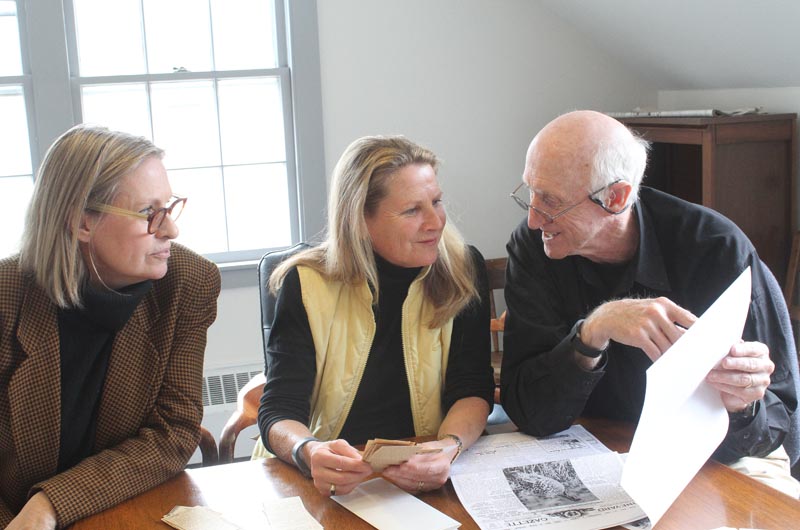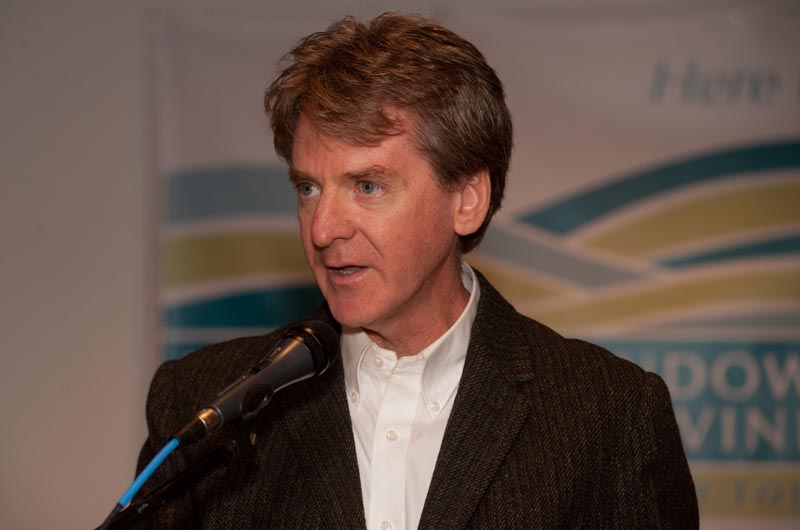Conservation on the Vineyard has a rich history, but one of the earliest modern conservation efforts was the ultimately futile effort to save the heath hen, the bird that came to only exist on the Island and slowly declined until the last heath hen died on the Island around 1932.
Now the heath hen is at the center of a new effort and a new debate on the Island, as scientific advances have made de-extinction a possibility. The heath hen is on a short list of animals being considered for de-extinction by a nonprofit organization.
The conservation community is divided when it comes to the idea of bringing back the heath hen, and scientists and conservation leaders said this week that the idea raises a host of ethical, ecological, logistical and even existential questions.
Some say the de-extinction of the heath hen is in line with and would further conservation goals, while others say a revived heath hen population may not be viable and the project could draw energy and financing away from saving endangered species alive today.
“I think the core thing is that this isn’t some sort of necessity,” said Ronald Sandler, a Northeastern University professor who specializes in the ethics of technology and environmental ethics. “It would be a kind of very interesting scientific and technological thing to do, and it might be something that’s valued by the local community, but it doesn’t solve a very large problem. The problem is that species are going extinct, species that already exist, and it doesn’t do much to address that problem. I mean people aren’t suffering from a lack of heath hen — and that’s not the conservation effort that’s primarily needed.”
“It’s an exciting proposal and an exciting possibility,” said Thomas French, assistant director of the Department of Fish and Wildlife for the state Natural Heritage and Endangered Species Program, noting that the heath hen is the only vertebrate that has gone completely extinct in Massachusetts. “This is one step short of Jurassic Park in a way. Technically it’s quite plausible, it’s quite feasible. But it’s never been done on any species, so there are a lot of hurdles.”
The heath hen, Tympanuchus Cupido Cupido, is a subspecies of prairie chicken and was once abundant along the East Coast. The bird was heavily hunted, and by the mid 1800s it only existed on Martha’s Vineyard.
On the Vineyard, scientists and residents observed the heath hen’s slow decline into extinction. There were efforts along the way to protect the species, including setting aside a swath of land as a heath hen preserve at what would become the Manuel F. Correllus State Forest. The state denied permits to bring in a prairie chicken for the last heath hen to mate with. That bird, a male nicknamed Booming Ben, was last seen on the Island in 1932.
The idea of bringing back the heath hen and other extinct species is being proposed by Revive & Restore, a nonprofit project within The Long Now Foundation. Revive & Restore is actively looking at reviving several species — beyond the heath hen, the passenger pigeon, woolly mammoth, and black-footed ferret are on the list.
The idea rests on genomic advances that could allow scientists to take DNA from museum specimens and work with a closely related species, in this case a prairie chicken or chicken. In short, using state-of-the-art technology to manipulate primordial germ cells, a prairie chicken could come to lay heath hen eggs.
In a late March visit to the Island, Revive & Restore executive director Ryan Phelan and co-founder Stewart Brand met with conservation leaders to explain the project and gauge public interest. They were joined by Susan Johnson Banta, who has been visiting the Vineyard for about 40 years and is serving as a community development consultant on this project.
Ms. Phelan has a background in genetics and was co-founder of the All Species Foundation. Mr. Brand, an author and ecologist, created and edited the Whole Earth catalog. They are married and live in Northern California.
Ms. Phelan and Mr. Brand stress that they are on the Island to pose a big idea. If there is local interest, they say, Revive & Restore could provide the science, while people on the Island spearhead the effort to revive the heath hen.
Ms. Phelan and Mr. Brand will participate in a forum next Thursday titled The Heath Hen Could Come Back from 6:30 to 8:30 p.m. at the Agricultural Hall. A panel presentation will be followed by discussion and a question-and-answer period moderated by Gazette writer Tom Dunlop. Other panelists include Josh Donlan, a specialist in island conservation, and Vineyard ecologists Tom Chase and Matt Pelikan who work for The Nature Conservancy.
“We’re really hoping that people come to the Ag Hall event with an open mind, curiosity and with a desire to actually explore what it would be like to be the first community to bring back an extinct species,” Ms. Phelan told the Gazette this week. “I think with that kind of attitude a lot of interesting conversation will take place.”
She said that while she and Mr. Brand did not know what to expect, initial conversations about the heath hen went surprisingly well.
“I think what we came away realizing was that everyone was so engaged with the concept,” she said. “I think they really embraced the idea that bringing the heath hen back could sort of serve as a way of galvanizing a lot of interest in conservation.”
Revive & Restore is looking for community engagement, she said. “Without that, I think it would be very hard . . . we want to be reactive and effective working with people from the Vineyard. We don’t want to foist an idea from the West Coast.”
Ms. Phelan said if there is enough interest, a feasibility study could get underway in the next year. With funding in place, the genomic sequencing could happen quickly. “If there are serious things that need to happen in terms of helping with predators and habitat restoration and any of those things, that can be a much different process,” she added.
“I think it can happen in five years if we want to make it happen,” she said. “Maybe 10 years . . . the lack of clarity is that nobody’s done it before. When there’s a will there’s a way with conservation efforts.”
The conversation next week will provide direction. “This is going to be a very informative month,” Ms. Phelan said. She and Mr. Brand will give out their email addresses and make themselves available for follow-up discussions and ad hoc meetings. “Or we might just be at the beach,” she said, “and this idea will be one that we stirred up.”
•
When it comes to de-extinction the scientific community is divided. “There is absolutely division,” Mr. Sandler said. “Some people see it as something that we might not want to do, but that we need to do in the face of very large amounts of species loss, especially species losses that we’re expecting to see with climate change. Whereas others think the risks involved are just much higher than the benefits we’re likely to get out of it.”
He said ethical issues run along two fronts: the size of the population brought back, and how long the animal has been extinct. A small, controlled population poses different concerns than an independent wild population, and recently extinct species provide better DNA and may still have habitat, as opposed to those that went extinct long ago.
There are concerns about siphoning resources from conserving existing species.
“The real conservation biology challenge is trying to prevent extinctions in the future,” Mr. Sandler said. “The other sort of related concern too is that if we develop the capability to bring back extinct species, will this undermine the urgency with which we think we need to conserve current species, because maybe we can just save their tissue sample and bring them back later.”
De-extinction poses the same animal welfare concerns as cloning and other similar processes, he said. Even if the process is possible, there could be failed attempts that lead to animals born with diseases and malformations.
Other issues include regulations and permitting.
While de-extinction could make up for past harm to the environment, “I think the benefits of this are often overstated,” Mr. Sandler said. “The technology doesn’t prevent extinctions. It doesn’t address the causes of extinctions and it’s going to be a really expensive and time-consuming process. There might be all kinds of benefits . . . but we don’t want to overstate this as something that’s important from a conservation perspective. That’s not what it’s really about.”
He said Revive & Restore is taking the right approach in looking for community interest. “I don’t think there’s anything inherently wrong with trying to do this,” he said.
Habitat could be a key hurdle, Mr. French said. Prairie chickens are known for being sensitive to habitat changes; plus the Vineyard has been built up since the last heath hen died and the Island might not have enough habitat for the bird, he said.
Predators are also a concern. “None of the grassland birds are faring well on the Vineyard,” Mr. French said. “So the idea of a ground-nesting bird that has a minimal amount of habitat is not going to work with the Vineyard as it currently exists. It’s questionable. It may turn out that the Vineyard might have been the last place, but not the best place now.”
Reintroducing heath hens to the state would require permitting, but Mr. French downplayed the obstacles. “That’s the least of the hurdles,” he said.
He said heath hen de-extinction falls within the state program’s mission. “The job of our whole program is to try to conserve species that are in jeopardy and try to restore ones that are gone,” he said. De-extinction is “to the extreme and right within the mission of our program. We usually talk about trying to restore things that have just receded to Connecticut.”
“Part of the philosophy is if they once occurred here, it’s legitimate to try to restore them,” he said.
“It’s just part of that fabric of our ecology,” he continued. “All the species that naturally occur here being a part of our environment, it just makes us richer for it . . . . It’s public policy to protect the biodiversity of the state and restore what we’ve lost. I don’t want to ever dissuade people from being ambitious in their desires to do things like this,” he said, concluding:
“I can’t wait. Count me in, I want to be there.”
•
Some Island conservation leaders took a more neutral stance.
“I think there’s interesting curiosity about the heath hen and this proposal, but there are also ethical concerns, and it raises questions about the nature of extinction and just our role on the planet,” said Adam Moore, executive director of the Sheriff’s Meadow Foundation. “What they are proposing causes one to ponder some very significant questions.”
He said Sheriff’s Meadow is not taking an active role in the proposal.
“This is a controversial subject,” Vineyard Conservation Society executive director Brendan O’Neill said in an email. “The burden rests with proponents to show they’ve thought it through.”
Tom Chase, director of conservation strategies for The Nature Conservancy on the Vineyard, embraces the idea of bringing the heath hen back, though maybe not to the Island.
More than a decade ago, Mr. Chase was involved in a project that looked at introducing prairie chickens to the Vineyard as part of sandplain grassland habitat restoration.
The idea was controversial, he said. It ultimately foundered because of inconclusive DNA about whether the heath hen was closely related to the prairie chicken and debate about what the sandplain habitat should be.
“My first thought was, here we go again,” Mr. Chase said, speaking of the de-extinction proposal. The previous experience made him stop and think about the ecological and biological barriers. And like Mr. French, he said a particular concern is ground predators like skunks.
“But really, an equally big thing is can the conservation movement, can all the conservation partners rally around something like this? That’s a really tall order,” Mr. Chase said.
Mr. Chase, Ms. Phelan and others said they were not concerned about diverting resources from existing work, noting that de-extinction brings new donors who would otherwise not get involved in conservation.
Luanne Johnson, a conservation biologist and director of Biodiversity Works who has spent much of her career working with endangered species, likes the idea. “I think you have nothing to lose in trying,” she said.
Ms. Johnson said the niche for a chicken-sized wild bird is vacant on the Vineyard, and she thinks some concerns could be overcome. Disease is already introduced with quail and pheasant that are released each year, she said, and while the skunk population has grown considerably, she notes that heath hens coexisted with predators for years, and the project could bring about efforts to control the predatory population.
“What’s the harm in trying?” she said. “Maybe extinction isn’t forever . . . wouldn’t it be cool if it wasn’t?”
Others were more cautious.
Island naturalist Gus Ben David, who has worked extensively with birds on the Island, said while the idea is fascinating, he doubts a real heath hen can be recreated. “Scientifically, perhaps, you could produce a facsimile,” he said. “Could it ever be the same as the original animal? No. So as far as reconstituting something that is going to go back into the Island and be viable, no. That’s my opinion . . . . You can never genetically recreate the set of genetics that existed at that time. Even when you breed something in captivity, it does not have that genetic sophistication to really survive in the wild.”
Mr. Ben David echoed others in saying that the bird’s habitat has been significantly altered since it became extinct.
“I’m not against it in relation to doing those things. It’s not really going to cause any harm,” he said. “It’s things that scientists do because we can do them. We go to the moon and do these things cause we can . . whether it’s a benefit to mankind, that remains questionable in a lot of situations.”











Comments (14)
Comments
Comment policy »